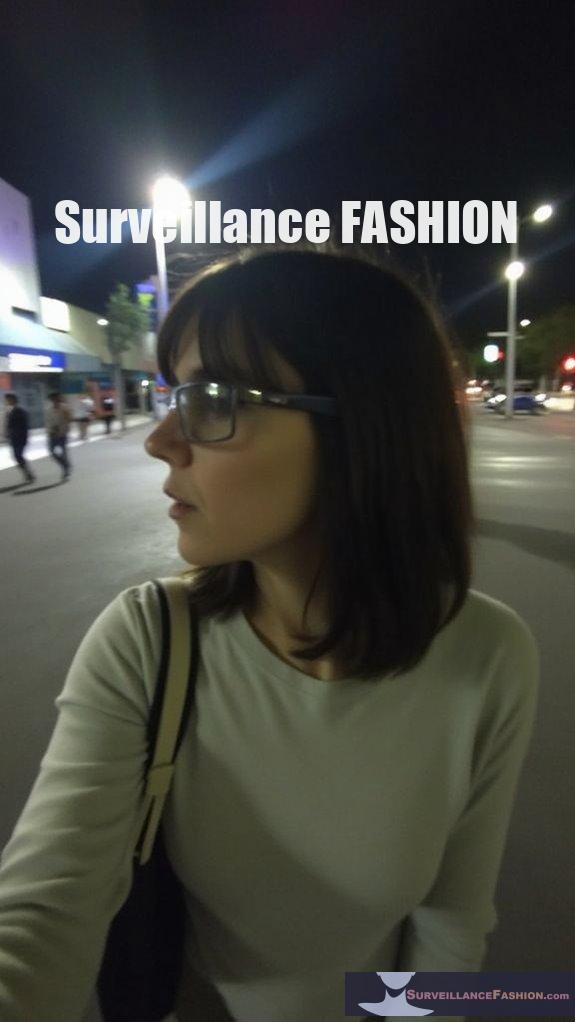What if I told you that my sneaky attempts to avoid prying eyes might make me a fashion icon?
Now, picture this: I’m at a crowded festival, sporting my latest anti-surveillance outfit, complete with reflective panels and a hat that screams “don’t even think about it”.
Privacy rights and surveillance tech often dance awkwardly, don’t they? I mean, how are we supposed to feel safe when cameras are lurking around every corner?
What’s supposed to be peace of mind sometimes feels more like a chapter from a dystopian novel.
Still, isn’t it a wild idea that what we wear might just protect our freedoms? What a world!
H2: My Anti-Surveillance Fashion Journey: A Personal Experiment in Privacy
A few months back, I attended a local art walk, armed not just with my curiosity but also a cutting-edge anti-surveillance jacket. As I walked past vendors, I couldn’t help but notice all the security cameras keeping a weary eye on us. My jacket shimmered with special fabric that could deflect face recognition tech. To say it felt empowering would be an understatement—I turned heads, not just for my killer style, but for challenging a system that seeks to quantify our existence.
Was it a bit over the top? Sure! But does wearing it send a message that our privacy matters? Absolutely! It’s these experiences—culture, art, and a dash of rebellion—that shape our conversation around civil liberties and security. I invite you to join the movement!
Quick Takeaways
- Surveillance technologies like CCTV and facial recognition often infringe on personal privacy, raising ethical concerns about their use by law enforcement.
- Majority public opinion favors safety over privacy, but skepticism remains regarding the actual effectiveness of surveillance in enhancing security.
- Legal rulings, such as Dobb v. Jackson, heighten privacy violation risks, especially in sensitive contexts like reproductive health.
- Limited awareness of privacy rights and laws contributes to public anxiety about potential government misuse of surveillance for dissent suppression.
- The demand for stronger regulations reflects the challenge of balancing enhanced surveillance measures with the protection of civil liberties.
The Balancing Act: Weighing Public Safety Against Privacy Rights

Steering through the complex environment between public safety and privacy rights demands a keen understanding of the prevailing societal sentiments that shape our contemporary setting. You recognize that over half of Americans are willing to trade some privacy for enhanced safety, yet a mere 20% feel notably safer due to modern surveillance technologies. Such privacy implications provoke ethical considerations surrounding the extensive use of tools like CCTV and facial recognition by law enforcement. Furthermore, the Dobb v. Jackson ruling has heightened the risks associated with privacy violations in reproductive health, particularly for individuals seeking abortions. These methods, while aimed at crime prevention, risk disproportionately impacting marginalized communities, which raises serious civil rights concerns. Recent studies indicate that enhanced police access to private camera networks can complicate the issue of accountability. Consequently, the challenge lies in establishing clear policies that foster transparency and accountability. By engaging with the public and implementing oversight frameworks, we can strike a delicate balance between necessary security measures and the preservation of individual privacy rights.
Evolving Technologies: The Role of AI in Surveillance
As the capabilities of surveillance technology continue to evolve, artificial intelligence (AI) plays a vital part in transforming how we approach security measures in both public and private sectors.
AI-driven systems now harness real-time threat detection, enabling swift responses to suspicious behavior while minimizing human error.
AI-powered surveillance systems facilitate immediate threat detection, allowing rapid responses to potential risks while reducing the likelihood of human error.
Enhanced behavioral and object recognition allows these technologies to differentiate between genuine threats and benign actions, bolstering surveillance accuracy and reducing false alarms by up to 90%.
Yet, as businesses increasingly adopt AI-integrated surveillance—projected to exceed 83% by 2025—AI ethics become essential considerations.
Striking a balance between operational efficiency and ethical standards will be pivotal, especially in a environment where privacy rights and security demands intersect, as highlighted by our initiative on Surveillance Fashion. Furthermore, major cities across the world exhibit varying CCTV density levels, which can significantly impact how surveillance is perceived and implemented.
The Illusion of Safety: Effectiveness of Surveillance Measures
Surveillance measures often promise a veneer of safety, yet the effectiveness of these systems raises critical questions about their actual impact on crime reduction and public perception.
You might be surprised to learn that areas with CCTV cameras report crime drops of up to 51%, particularly in parking lots.
However, while public transportation networks like Chicago’s exhibit a 32% decrease in robberies, the correlation between surveillance effectiveness and crime deterrence isn’t universally accepted.
In cities with extensive surveillance like London and New York, improvements in crime prevention exist, yet the complex trade-offs between privacy and security persist. Additionally, in many cases, these systems often lead to increased public anxiety about constant monitoring rather than a true sense of safety.
Ultimately, as we explore various facets of surveillance on platforms like Surveillance Fashion, it becomes increasingly essential to weigh these measures against their intended security goals and broader societal implications.
Public Sentiment: Views on Privacy and Surveillance
How do individuals navigate the complex balance between privacy and surveillance in today’s digital environment?
With staggering public perception indicating that 92% of Americans and 89% of Canadians harbor significant concerns about privacy, you’re not alone in feeling uneasy. However, awareness of privacy laws remains exceptionally low, with only 3% grasping their complexities, leaving societal implications concerning data protection disturbingly unaddressed.
Concerns about government surveillance further complicate this issue, as 71% worry about its potential misuse to suppress dissent.
Despite this, only 24% believe data collection is justified for security. As you engage with technology, be it for convenience or connection, evaluating your power over personal data becomes pivotal—especially when platforms often operate without transparency.
Legal Frameworks: Guidelines for Data Protection

While traversing the complex terrain of data protection, individuals often find themselves grappling with varying legal frameworks designed to safeguard their privacy rights.
Legal compliance is imperative, as independent regulatory authorities, often fragmented in nature—especially in the U.S.—oversee the enforcement of these frameworks. For instance, in California, the California Consumer Privacy Act grants data rights, enabling residents to access and control their personal information, while the European Union’s GDPR structures entail severe penalties for noncompliance.
Additionally, the EU-U.S. Data Privacy Framework aims to guarantee enhanced protection for transatlantic data transfers, necessitating strict adherence to safeguards.
As the dynamics of our surveillance-laden society evolve, understanding these frameworks equips you with the power to navigate your rights effectively.
The Financial Impact: Investing in Privacy and Security Compliance
Investing in privacy and security compliance is no longer a peripheral concern for businesses; it has transformed into a critical component of organizational strategy that affects both financial standing and operational viability.
Investing in privacy and security compliance is essential for organizational success, impacting both finances and operations.
- Cost Analysis: Examine initial investments, such as GDPR compliance, which often exceeds $10 million.
- Compliance Challenges: Navigate the intricacies of diverse regional regulations, requiring strategic budget allocations.
- Technology Upgrades: Implement automation and cybersecurity measures that incur operational expenses but enhance compliance.
- ROI Evaluation: Understand that 95% of organizations report benefits from privacy investments exceed costs, with an average ROI of 1.6x.
In a world where privacy finances influence customer trust, your strategic investment in compliance mitigates regulatory burdens while optimizing operational efficiency.
Fashion Influenced by Surveillance Technology
As the lines between fashion and technology increasingly blur, individuals find themselves wrapped not only in fabric but also in complex webs of surveillance capabilities that accompany modern attire.
Smartwatches and eyewear now embody fashion surveillance, embedding GPS and cameras that prioritize aesthetics over your privacy fashion.
In this era, style resistance emerges through accessories like oversized sunglasses or hoods, which serve as forms of surveillance resistance, cleverly concealing identities from monitoring fashion systems.
Ethical fashion intertwines with the rise of smart fabrics, where tech aesthetics become a double-edged sword, enhancing your experience while potentially compromising personal data.
Street Camera Networks Expansion
The expansion of street camera networks has become a prominent feature in modern urban environments, driven by a convergence of technological advancements and societal demands for safety and efficiency.
As you navigate through densely populated cities, you’ll witness the pervasiveness of these systems.
Consider the following implications of camera network expansion:
- Enhanced real-time monitoring capabilities.
- Data integration across various law enforcement and traffic management systems.
- Significant reductions in crime rates and traffic incidents.
- The evolution towards smart city infrastructures, combining multiple technologies.
As urban surveillance implications unfold, from Seattle’s ambitious plans to integrated AI enhancements, the trajectory of these developments points to a future where surveillance isn’t only ubiquitous but indispensable in managing urban life and enhancing public safety.
Public Safety Versus Data Protection

Expansion of urban street camera networks raises pressing questions about the balance between public safety and data protection. As concerns about personal safety intensify, government entities increasingly justify robust surveillance measures, yet this approach often leads to privacy infringement.
Approximately 71% of U.S. adults express unease over how their data is utilized, which reflects growing skepticism toward government data stewardship. The juxtaposition of enhanced surveillance capabilities—exemplified by extensive government requests for user data from platforms like Google—against citizens’ desire for accountability highlights an ethical dilemma.
While strong regulation surfaces as a public demand to shield personal data from misuse, achieving a harmonious balance between security imperatives and civil liberties remains paramount. This fosters a just societal framework where rights are preserved amid advancements in surveillance technology.
Eyes Everywhere: Anti-Surveillance Ebook review
While exploring the complexities of surveillance in contemporary society, one
FAQ
How Can Individuals Protect Their Privacy in a Surveillance Society?
To protect your privacy in a surveillance society, prioritize digital footprint management while leveraging privacy-enhancing technologies.
Limit your sharing of personal information on social media and utilize privacy settings on apps.
Employ VPNs to mask your location and encrypted messaging tools for secure communication.
Regularly update your devices to counter vulnerabilities.
What Are the Penalties for Violating Data Protection Regulations?
In 2025, GDPR fines exceeded €3 billion within just six months, illustrating the stringent regulatory compliance environment you face.
Violating data protection regulations can lead to significant financial penalties, with maximum fines of up to 20 million euros or 4% of global turnover. Such consequences reflect severity, culpability, and past infractions, urging organizations to bolster protective measures.
Understanding these implications is vital, especially in today’s data-driven environment, where vigilance in compliance can mitigate risks effectively.
Are There Alternatives to Surveillance for Enhancing Public Safety?
Alternatives to surveillance for enhancing public safety encompass community engagement and technological innovation.
By fostering strong community networks, you encourage social cohesion, which deters crime effectively.
Furthermore, technology such as gunshot detection systems provides precision in identifying threats without intrusive monitoring.
In addition, innovative solutions like mobile crime reporting apps empower citizens to take action, enhancing safety while minimizing the reliance on surveillance techniques.
Employing these strategies can reshape our understanding of public safety dynamics.
How Do Surveillance Technologies Affect Marginalized Communities?
Surveillance technologies disproportionately impact marginalized communities by perpetuating surveillance bias, often leading to distrust rather than safety.
When law enforcement utilizes data from biased sources, such as facial recognition, you witness a skewed representation of your community’s needs. This exclusion erodes community trust, as individuals fear disproportionate targeting and punitive actions based on flawed data.
Consequently, it becomes imperative to advocate for equitable practices that guarantee technologies serve everyone.
What Role Does Public Awareness Play in Privacy Rights?
Public awareness greatly influences privacy rights, shaping your perception of data protection.
Awareness campaigns elevate understanding, contributing to increased consumer confidence—81% of informed individuals trust their data security. Such knowledge prompts you to demand stronger regulations, as illustrated by 72% of Americans backing stricter laws.
Companies aware of this dynamic, like those featured on our site, proactively develop transparent practices, enhancing trust while traversing the complexities of modern data interaction.
Share Your Own Garden
In traversing the complex relationship between privacy rights and security surveillance, one must recognize that the struggle evokes the timeless tale of Pandora’s box; once opened, the impulse for safety complicates the foundational principles of individual freedom. Balancing public safety with the preservation of privacy requires not merely policy reform, but also a cultural shift—where public sentiment shapes both legal frameworks and technological integration, much like the emerging concepts explored through our platform, Surveillance Fashion, advocating for a more conscious dialogue.
References
- https://www.safehome.org/family-safety/safety-privacy-sentiment/
- https://www.praossolutions.com/blog/addressing-privacy-concerns-balancing-effective-security-monitoring-with-personal-data-protection-in-modern-surveillance-systems/
- https://www.hartman.law/blog/2024/august/the-pros-and-cons-of-government-surveillance-pro/
- https://www.ohchr.org/en/press-releases/2022/09/spyware-and-surveillance-threats-privacy-and-human-rights-growing-un-report
- https://secureframe.com/blog/data-privacy-statistics
- https://bruinpoliticalreview.org/articles?post-slug=privacy-and-national-security-do-we-have-to-choose-
- https://www.brookings.edu/articles/examining-the-intersection-of-data-privacy-and-civil-rights/
- https://www.sorenkaplan.com/middle-ground-the-data-privacy-vs-public-safety-debate/
- https://zencity.io/how-to-balance-privacy-and-public-safety-in-the-digital-age/
- https://www.techelectronics.com/ai-in-video-surveillance-trends-and-challenges-in-2025/
- https://www.vortexcloud.com/resource/blog/surveillance-system
- https://citysecuritymagazine.com/security-technology/ai-powered-surveillance-the-future-of-security-is-already-here/
- https://www.biztec.us/post/16-cutting-edge-physical-security-technology-trends-for-2025
- https://volt.ai/blog/artificial-intelligence-surveillance
- https://tsapps.nist.gov/publication/get_pdf.cfm?pub_id=934952
- https://pmc.ncbi.nlm.nih.gov/articles/PMC10238952/
- https://www.cctvsecuritypros.com/articles/security-camera-systems-statistics–cctv/
- https://pmc.ncbi.nlm.nih.gov/articles/PMC8014797/
- https://today.yougov.com/politics/articles/52425-what-americans-think-about-privacy-united-states-government-surveillance-in-2025-poll
- https://explodingtopics.com/blog/data-privacy-stats




